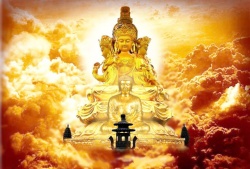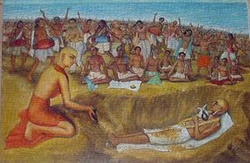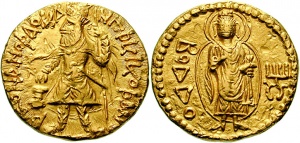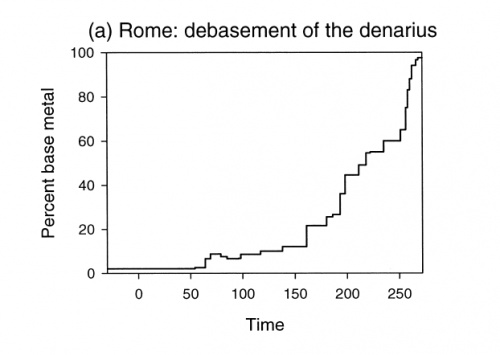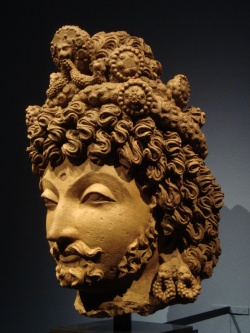Difference between revisions of "Rome, Persia, China and Indian Buddhism"
(Created page with "{{DisplayImages|4094|4128|3599|1262|4479|2431|893|2691}} {{Centre|<big><big>Rome, Persia, China and Indian Buddhism</big></big><br/> By Indrajala (Jeffrey Kotyk)}}<br/><br...") |
|||
| Line 3: | Line 3: | ||
By [[Indrajala (Jeffrey Kotyk)]]}}<br/><br/> | By [[Indrajala (Jeffrey Kotyk)]]}}<br/><br/> | ||
| − | Discussion of classical Indian Buddhism in the early centuries of the first millennium has generally been done within the geographical limits of the Indosphere stretching from what is now Afghanistan down through to Sri Lanka. While Buddhism in the early centuries did expand outside this region to areas like Central Asia and China, Buddhism as a major institution and civilization was in the 3rd century still largely limited to the subcontinent and Persian borderlands. However, the fortunes of Buddhism in the second through fourth centuries CE have to be understood within a greater geopolitical context stretching from the Roman Empire across Asia to China. The prosperity and misfortunes that Buddhism experienced in India were in fact intricately tied to international trade and commerce. | + | [[Discussion]] of classical [[Indian Buddhism]] in the early centuries of the first millennium has generally been done within the geographical limits of the Indosphere stretching from what is now {{Wiki|Afghanistan}} down through to [[Sri Lanka]]. While [[Buddhism]] in the early centuries did expand outside this region to areas like {{Wiki|Central Asia}} and [[China]], [[Buddhism]] as a major institution and {{Wiki|civilization}} was in the 3rd century still largely limited to the subcontinent and [[Persian]] borderlands. However, the fortunes of [[Buddhism]] in the second through fourth centuries CE have to be understood within a greater geopolitical context stretching from the {{Wiki|Roman Empire}} across {{Wiki|Asia}} to [[China]]. The [[prosperity]] and misfortunes that [[Buddhism]] [[experienced]] in [[India]] were in fact intricately tied to international trade and commerce. |
| − | Giovanni Verardi in his recent work http://h-net.msu.edu/cgi-bin/logbrowse.pl?trx=vx&list=H-Buddhism&month=1109&week=b&msg=TEoBEb8S9F3TIi/ASANIqA Hardships and Downfall of Buddhism in India] explains how Buddhism in India established an “open | + | Giovanni Verardi in his recent work http://h-net.msu.edu/cgi-bin/logbrowse.pl?trx=vx&list=H-Buddhism&month=1109&week=b&msg=TEoBEb8S9F3TIi/ASANIqA {{Wiki|Hardships}} and Downfall of [[Buddhism in India]]] explains how [[Buddhism in India]] established an “open {{Wiki|society}}” across the subcontinent which was effectively an urban pro-trade {{Wiki|social}} model in contrast to the competing [[Brahman]] agrarian model based on [[caste]]. Whereas the [[sangha]] was dependent on and intimately connected to commercial [[activities]] and the {{Wiki|merchant}} classes for funding and [[protection]], the [[Brahmans]] sought to secure an alternative agrarian order which provided them with supreme authority, even over [[kṣatriya]] [[kings]]. Such competing {{Wiki|social}} models inevitably led to conflict. |
| − | One might even describe it as class warfare. In the traditional caste system a merchant is given a lower position, so it is unsurprising that they might support Buddhism which rejected a preordained social order, and moreover provided merchants with prestigious status as benefactors as well as the opportunity for spiritual attainment. It was also in the interests of some kṣatriya kings to favour Buddhism as they could emulate the cakravartin ideal and increase their power base through taxation of merchants, whereas in the orthodox Vedic model they were supposed to give gifts of cattle and tax-free land to Brahmans, as well as act as caretaker of a throne with the real political power being held by the Brahman priests. | + | One might even describe it as class warfare. In the [[traditional]] [[caste]] system a {{Wiki|merchant}} is given a lower position, so it is unsurprising that they might support [[Buddhism]] which rejected a preordained {{Wiki|social}} order, and moreover provided {{Wiki|merchants}} with prestigious {{Wiki|status}} as benefactors as well as the opportunity for [[spiritual]] [[attainment]]. It was also in the interests of some [[kṣatriya]] [[kings]] to favour [[Buddhism]] as they could emulate the [[cakravartin]] {{Wiki|ideal}} and increase their power base through taxation of {{Wiki|merchants}}, whereas in the {{Wiki|orthodox}} {{Wiki|Vedic}} model they were supposed to give gifts of cattle and tax-free land to [[Brahmans]], as well as act as caretaker of a [[throne]] with the real {{Wiki|political}} power being held by the [[Brahman]] {{Wiki|priests}}. |
| − | The well-being and sustainability of Buddhism in India in this period effectively rested on trade, which in India was part of a larger pan-Eurasian network stretching from Rome to China. In this period Buddhism had already changed into a highly organized Vinaya-based monastic model. It grew increasingly complex by assembling an extensive written canon that needed to be continually physically reproduced. It further came to have sophisticated artistic traditions. All of this required resources and people plus continual investments to maintain everything. The monastic model in India was parasitic on the economy. It generally consumed resources and did not produce much in the way of agricultural products or commodities, though it did function in the tertiary sector of the economy. Buddhist institutions often operated money lending and storage services. All things considered, Buddhism was a capital intensive religion, much as it largely still is in most of Asia. Predictably, any disruption to capital inputs naturally undermined the religion, which indeed is what happened. | + | The well-being and sustainability of [[Buddhism in India]] in this period effectively rested on trade, which in [[India]] was part of a larger pan-Eurasian network stretching from {{Wiki|Rome}} to [[China]]. In this period [[Buddhism]] had already changed into a highly organized Vinaya-based [[monastic]] model. It grew increasingly complex by assembling an extensive written [[canon]] that needed to be continually {{Wiki|physically}} reproduced. It further came to have sophisticated artistic [[traditions]]. All of this required resources and [[people]] plus continual investments to maintain everything. The [[monastic]] model in [[India]] was parasitic on the {{Wiki|economy}}. It generally consumed resources and did not produce much in the way of agricultural products or commodities, though it did [[function]] in the tertiary sector of the {{Wiki|economy}}. [[Buddhist]] {{Wiki|institutions}} often operated [[money]] lending and storage services. All things considered, [[Buddhism]] was a capital intensive [[religion]], much as it largely still is in most of {{Wiki|Asia}}. Predictably, any disruption to capital inputs naturally undermined the [[religion]], which indeed is what happened. |
| − | It is interesting to consider how the political developments and plagues that occurred in such distant lands could have impacted Buddhism on the subcontinent in such a deep way, though we have only to think of the so-called Silk Road to the north and transoceanic trade to the south which kept goods, bullion and coinage in circulation around Eurasia. The trade between India and China is widely understood in Buddhist circles, though the relations between Rome and India are less known. Romila Thapar explains the significance of the trade: | + | It is [[interesting]] to consider how the {{Wiki|political}} developments and plagues that occurred in such distant lands could have impacted [[Buddhism]] on the subcontinent in such a deep way, though we have only to think of the so-called [[Silk Road]] to the [[north]] and transoceanic trade to the [[south]] which kept goods, bullion and coinage in circulation around {{Wiki|Eurasia}}. The trade between [[India]] and [[China]] is widely understood in [[Buddhist]] circles, though the relations between {{Wiki|Rome}} and [[India]] are less known. Romila Thapar explains the significance of the trade: |
| − | : Roman historian Pliny complained of the trade with the east being a serious drain on the income of Rome, to the extent of 550 million sesterces each year, of which at least a fifth went to India. Imports from India were largely luxury articles - spices, jewels, textiles, ivories and animals (apes, parrots and peacocks) for the amusement of the Roman patrician and his family. It was therefore thought that the balance of trade was in favour of India. But recently it has been argued that even if Pliny's figure is correct, customs dues and taxes on the imports from the east into Roman Egypt were high enough to compensate for the drain of money in the initial outlay for this trade. It has also been argued that Tiberius and later Pliny, both of whom complained about the drain of Roman wealth to India, may have been more concerned about making a moral judgement on Roman patrician society with its display of wealth, and therefore used the trade to underline the point. Nevertheless, it was a profitable trade for the merchants and chiefs of the Indian peninsula.<ref>{{Nolinking|Romila Thapar, The Penguin History of Early India From the Origins to AD 1300 (London, England: Penguin Books Ltd, 2002), 242-243.}}</ref> | + | : {{Wiki|Roman}} historian Pliny complained of the trade with the [[east]] being a serious drain on the income of {{Wiki|Rome}}, to the extent of 550 million sesterces each year, of which at least a fifth went to [[India]]. Imports from [[India]] were largely {{Wiki|luxury}} articles - spices, [[jewels]], textiles, ivories and [[animals]] (apes, parrots and [[peacocks]]) for the amusement of the {{Wiki|Roman}} patrician and his family. It was therefore [[thought]] that the [[balance]] of trade was in favour of [[India]]. But recently it has been argued that even if Pliny's figure is correct, customs dues and taxes on the imports from the [[east]] into {{Wiki|Roman}} {{Wiki|Egypt}} were high enough to compensate for the drain of [[money]] in the initial outlay for this trade. It has also been argued that Tiberius and later Pliny, both of whom complained about the drain of {{Wiki|Roman}} [[wealth]] to [[India]], may have been more concerned about making a [[moral]] [[judgement]] on {{Wiki|Roman}} patrician {{Wiki|society}} with its display of [[wealth]], and therefore used the trade to underline the point. Nevertheless, it was a profitable trade for the {{Wiki|merchants}} and chiefs of the [[Indian]] peninsula.<ref>{{Nolinking|Romila Thapar, The Penguin History of Early India From the Origins to AD 1300 (London, England: Penguin Books Ltd, 2002), 242-243.}}</ref> |
| − | The peak of Buddhist power in India occurred during flourishing trade with Rome but also the era of foreign rule over the subcontinent by the [http://www.iranicaonline.org/articles/kushan-dynasty-i-history Kuṣāṇa dynasty] (1st-3rd centuries CE): | + | The peak of [[Buddhist]] power in [[India]] occurred during flourishing trade with {{Wiki|Rome}} but also the {{Wiki|era}} of foreign rule over the subcontinent by the [http://www.iranicaonline.org/articles/kushan-dynasty-i-history Kuṣāṇa dynasty] (1st-3rd centuries CE): |
| − | : The foreign dynasties that from the first century BC to the second century AD ruled over a considerable part of India could not make themselves into 'national' dynasties, and allowed Buddhism, and also neo-Brahmanical movements, to grow. The case of Kaniṣka I is particularly interesting. Under his reign (second quarter of the second century AD), Indian Buddhism reached, as documented by the imposing building activity and the iconographic output, its greatest economic power and territorial expansion.<ref>{{Nolinking|Giovanni Veraridi, Hardships and Downfall of Buddhism in India (New Delhi, India: Manohar, 2011), 91.}}</ref> | + | : The foreign dynasties that from the first century BC to the second century AD ruled over a considerable part of [[India]] could not make themselves into 'national' dynasties, and allowed [[Buddhism]], and also neo-Brahmanical movements, to grow. The case of [[Wikipedia:Kanishka|Kaniṣka]] I is particularly [[interesting]]. Under his reign (second quarter of the second century AD), [[Indian Buddhism]] reached, as documented by the imposing building [[activity]] and the iconographic output, its greatest economic power and territorial expansion.<ref>{{Nolinking|Giovanni Veraridi, Hardships and Downfall of Buddhism in India (New Delhi, India: Manohar, 2011), 91.}}</ref> |
[[File:KanishkaI.jpg|centre|thumb|300px|Gold coin of Kaniṣka I with Buddha image.]] | [[File:KanishkaI.jpg|centre|thumb|300px|Gold coin of Kaniṣka I with Buddha image.]] | ||
| − | The trade throughout Kuṣāṇa territories was heavily influenced by Rome as well. Thapar notes that “the gold coins of the Kushanas followed the Roman weight standard, partly to ensure that they would be used as legal tender in areas familiar with Roman trade. The imitation of particular coins probably had more to do with the continuity of a medium of exchange than with fashion.”<ref>{{Nolinking|Romila Thapar, 253.}}</ref> Furthermore, “products that were in demand in Roman markets were exchanged mainly for Roman coins. The frequency of hoards of such coins in the Deccan and south India point to its being a trade of some substance. Most of the coins are of earlier Roman Emperors, such as Augustus and Tiberius, the debased coins of Nero not being thought worthy of hoarding.”<ref>{{Nolinking|Ibid., 242.}}</ref> | + | The trade throughout [[Wikipedia:Kusana|Kuṣāṇa]] territories was heavily influenced by {{Wiki|Rome}} as well. Thapar notes that “the {{Wiki|gold coins}} of the Kushanas followed the {{Wiki|Roman}} weight standard, partly to ensure that they would be used as legal tender in areas familiar with {{Wiki|Roman}} trade. The imitation of particular coins probably had more to do with the continuity of a {{Wiki|medium}} of exchange than with fashion.”<ref>{{Nolinking|Romila Thapar, 253.}}</ref> Furthermore, “products that were in demand in {{Wiki|Roman}} markets were exchanged mainly for {{Wiki|Roman}} coins. The frequency of hoards of such coins in the Deccan and [[south]] [[India]] point to its being a trade of some [[substance]]. Most of the coins are of earlier {{Wiki|Roman}} [[Emperors]], such as Augustus and Tiberius, the debased coins of Nero not being [[thought]] [[worthy]] of hoarding.”<ref>{{Nolinking|Ibid., 242.}}</ref> |
| − | While Kaniṣka and the Kuṣāṇa dynasty were not strictly Buddhist, they did support the sangha. Their trade policies also fostered favorable conditions in which Buddhist institutions thrived. The well-being of Buddhism partially relied on Indian trade with Rome. It is thus unsurprising that “once the conditions created by Kuṣāṇa rule dissolved, and the imposing building activity and impressive amount of artistic output in key-cities like Mathurā and in Buddhist sanctuaries came to a halt, India, besides being de-urbanised, appeared as an iconic desert.”<ref>{{Nolinking|Giovanni Verardi, 107.}}</ref> | + | While [[Wikipedia:Kanishka|Kaniṣka]] and the [[Wikipedia:Kusana|Kuṣāṇa]] {{Wiki|dynasty}} were not strictly [[Buddhist]], they did support the [[sangha]]. Their trade policies also fostered favorable [[conditions]] in which [[Buddhist]] {{Wiki|institutions}} thrived. The well-being of [[Buddhism]] partially relied on [[Indian]] trade with {{Wiki|Rome}}. It is thus unsurprising that “once the [[conditions]] created by [[Wikipedia:Kusana|Kuṣāṇa]] rule dissolved, and the imposing building [[activity]] and impressive amount of artistic output in key-cities like {{Wiki|Mathurā}} and in [[Buddhist]] sanctuaries came to a halt, [[India]], besides being de-urbanised, appeared as an {{Wiki|iconic}} desert.”<ref>{{Nolinking|Giovanni Verardi, 107.}}</ref> |
| − | Any disruption of international trade would have undermined Buddhist institutions, and this is precisely what happened. It was not just declining trade with Rome, but also China. Again, Verardi: | + | Any disruption of international trade would have undermined [[Buddhist]] {{Wiki|institutions}}, and this is precisely what happened. It was not just declining trade with {{Wiki|Rome}}, but also [[China]]. Again, Verardi: |
| − | : There is little doubt that the closing down of the open society of the Buddhists and the resulting weakening of the religion of Dharma coincides with the fall in international trading activities, and in particular with the much decreased demand for Indian goods from Rome. Kuṣāṇa currency, circulating over a vast territory, had been linked to the Roman currency system. The collapse of the Han dynasty in China (AD 221) contributed to changing the picture in Central Asia. By that time, we observe a change in the Indian landscape, namely, a rapid process of de-urbanisation. It is every archaeologist's experience that even in the case of continuous human occupation, post-Kuṣāṇa levels display much poorer building techniques and reuse of earlier building material. A great number of small and large towns were abandoned in the third century, and in certain areas, as is shown by territorial surveys, the collapse of a whole network of roads and small settlements, which had been kept functioning by Buddhist monasteries, is observable. This process was probably aggravated by the collapse of the trading activity with the West that followed St Cyprian's plague of the years AD 251-66, which is an important component of the 'crisis of the third century' in the {{Wiki|Roman Empire}}.<ref>{{Nolinking| Ibid., 106.}}</ref> | + | : There is little [[doubt]] that the closing down of the open {{Wiki|society}} of the [[Buddhists]] and the resulting weakening of the [[religion]] of [[Dharma]] coincides with the fall in international trading [[activities]], and in particular with the much decreased demand for [[Indian]] goods from {{Wiki|Rome}}. [[Wikipedia:Kusana|Kuṣāṇa]] currency, circulating over a vast territory, had been linked to the {{Wiki|Roman}} currency system. The collapse of the {{Wiki|Han dynasty}} in [[China]] (AD 221) contributed to changing the picture in {{Wiki|Central Asia}}. By that [[time]], we observe a change in the [[Indian]] landscape, namely, a rapid process of de-urbanisation. It is every archaeologist's [[experience]] that even in the case of continuous [[human]] {{Wiki|occupation}}, post-Kuṣāṇa levels display much poorer building techniques and reuse of earlier building material. A great number of small and large towns were abandoned in the third century, and in certain areas, as is shown by territorial surveys, the collapse of a whole network of roads and small settlements, which had been kept functioning by [[Buddhist]] [[monasteries]], is observable. This process was probably aggravated by the collapse of the trading [[activity]] with the [[West]] that followed St Cyprian's plague of the years AD 251-66, which is an important component of the 'crisis of the third century' in the {{Wiki|Roman Empire}}.<ref>{{Nolinking| Ibid., 106.}}</ref> |
| − | I would add that prior to St Cyprian's plague, there had been another plague starting a century prior which severely damaged the Roman economy and significantly decreased the population: the Antonine plague which reached the empire in 165. Within a few years it had annihilated a sizable portion of tax payers in Egypt alone, which was also the bread basket of the empire. There were further outbreaks of plague in 172, 174, 175, 179, 182 and 189, and thereafter again in the 250s and 260s. During the Fayum area of Egypt during the Antonine plague the tax base dropped 33-44%. Other areas saw declines up to 93%, though some of that would have been as a result of flight. | + | I would add that prior to St Cyprian's plague, there had been another plague starting a century prior which severely damaged the {{Wiki|Roman}} {{Wiki|economy}} and significantly decreased the population: the Antonine plague which reached the [[empire]] in 165. Within a few years it had {{Wiki|annihilated}} a sizable portion of tax payers in {{Wiki|Egypt}} alone, which was also the bread basket of the [[empire]]. There were further outbreaks of plague in 172, 174, 175, 179, 182 and 189, and thereafter again in the 250s and 260s. During the Fayum area of {{Wiki|Egypt}} during the Antonine plague the tax base dropped 33-44%. Other areas saw declines up to 93%, though some of that would have been as a result of flight. |
| − | One estimate states up to 10% of the empire's total population perished, though alternative estimates would suggest upwards of 30% might have died, which would have been comparable to the Black Death in western Europe between 1347-80. This occurred when the empire was already under enormous demographic-structural stress. Sociopolitical instability and the subsequent endemic civil war of the third century prevented population recovery and only contributed to the slow downfall of Rome over the following two centuries.<ref>{{Nolinking|Peter Turchin and Sergey A. Nefedov, Secular Cycles (Princeton, New Jersey: Princeton University Press, 2009), 233-235.}}</ref> All of this no doubt contributed to the currency debasement of the later empire, which is illustrated in the following chart:<ref>{{Nolinking|Ibid., 221.}}</ref> | + | One estimate states up to 10% of the empire's total population perished, though alternative estimates would suggest upwards of 30% might have [[died]], which would have been comparable to the Black [[Death]] in {{Wiki|western}} {{Wiki|Europe}} between 1347-80. This occurred when the [[empire]] was already under enormous demographic-structural [[stress]]. Sociopolitical instability and the subsequent endemic civil [[war]] of the third century prevented population recovery and only contributed to the slow downfall of {{Wiki|Rome}} over the following two centuries.<ref>{{Nolinking|Peter Turchin and Sergey A. Nefedov, Secular Cycles (Princeton, New Jersey: Princeton University Press, 2009), 233-235.}}</ref> All of this no [[doubt]] contributed to the currency debasement of the later [[empire]], which is [[illustrated]] in the following chart:<ref>{{Nolinking|Ibid., 221.}}</ref> |
[[File:Romedebasementw4324.jpg|frameless|centre|500px|]] | [[File:Romedebasementw4324.jpg|frameless|centre|500px|]] | ||
| − | Under Domitian (reigned 81-96) the silver content of the denarius was 3.28 grams, but by the end of the following century the silver equivalent had fallen to just 2 grams. By 272 the denarius only had 2.5% silver in it. By the time St Cyprian's plague hit in 251, the Roman empire was already suffering critical financial problems, which contributed to the fall in international trading activities. | + | Under Domitian (reigned 81-96) the {{Wiki|silver}} content of the denarius was 3.28 grams, but by the end of the following century the {{Wiki|silver}} {{Wiki|equivalent}} had fallen to just 2 grams. By 272 the denarius only had 2.5% {{Wiki|silver}} in it. By the [[time]] St Cyprian's plague hit in 251, the {{Wiki|Roman empire}} was already [[suffering]] critical financial problems, which contributed to the fall in international trading [[activities]]. |
| − | Verardi also rightfully notes another contributing factor in that decline: the collapse of the Han dynasty in around 220 CE. The Han Dynasty is divded into the western or former Han (206-9 BCE) and the later or eastern Han (25-220 CE). It was during the latter that important local changes unfolded which inevitably reduced China's contribution to the aforementioned pan-Eurasian trade network which Indian Buddhism depended on. | + | Verardi also rightfully notes another contributing factor in that {{Wiki|decline}}: the collapse of the {{Wiki|Han dynasty}} in around 220 CE. The {{Wiki|Han Dynasty}} is divded into the {{Wiki|western}} or former Han (206-9 BCE) and the later or eastern Han (25-220 CE). It was during the latter that important local changes unfolded which inevitably reduced [[China's]] contribution to the aforementioned pan-Eurasian trade network which [[Indian Buddhism]] depended on. |
| − | Emperor Guangwu 光武帝 (reigned 25-57 CE) abandoned an earlier offensive strategy along the north frontier against the Xiongnu (barbarian horsemen), who subsequently increasingly engaged in profitable raiding. Populations fled to the south leaving many areas depopulated. Nomads had to be settled in abandoned regions to fend off the Xiongnu. Between 2-140 CE the formally registered population in the north-west dropped by 70%, while the population in the south increased as much as 100% in some regions. | + | [[Emperor]] Guangwu 光武帝 (reigned 25-57 CE) abandoned an earlier [[offensive]] strategy along the [[north]] frontier against the {{Wiki|Xiongnu}} ([[barbarian]] horsemen), who subsequently increasingly engaged in profitable raiding. Populations fled to the [[south]] leaving many areas depopulated. Nomads had to be settled in abandoned regions to fend off the {{Wiki|Xiongnu}}. Between 2-140 CE the formally registered population in the north-west dropped by 70%, while the population in the [[south]] increased as much as 100% in some regions. |
| − | Despite the defeat of the Xiongnu confederation in the 80s, the Xianbei and Qiang tribes replaced them and continued causing trouble for the Han court. Rebellions occurred and provinces were abandoned. In 143 official salaries were reduced and the court had to start borrowing money, demonstrating severe financial problems. In the end the last Han emperor abdicated to warlord Cao Cao's son in 220, marking the end of a nominally unified Chinese empire and the beginning of a ghastly period of perpetual war and instability.<ref>{{Nolinking|See Mark Edward Lewis, The Early Chinese Empires Qin and Han (Cambridge, Massachusetts: The Belknap Press of Harvard University Press, 2007), 24-29.}}</ref> All this meant a sharp decline in Chinese exports and imports. | + | Despite the defeat of the {{Wiki|Xiongnu}} confederation in the 80s, the {{Wiki|Xianbei}} and {{Wiki|Qiang}} tribes replaced them and continued causing trouble for the Han court. Rebellions occurred and provinces were abandoned. In 143 official salaries were reduced and the court had to start borrowing [[money]], demonstrating severe financial problems. In the end the last Han [[emperor]] abdicated to warlord Cao Cao's son in 220, marking the end of a nominally unified {{Wiki|Chinese}} [[empire]] and the beginning of a ghastly period of [[perpetual]] [[war]] and instability.<ref>{{Nolinking|See Mark Edward Lewis, The Early Chinese Empires Qin and Han (Cambridge, Massachusetts: The Belknap Press of Harvard University Press, 2007), 24-29.}}</ref> All this meant a sharp {{Wiki|decline}} in {{Wiki|Chinese}} exports and imports. |
| − | One other important factor in the decline of international trade that Verardi does not mention was the collapse of the Parthian empire. Parthia incidentally had a role to play in the aforementioned plague outbreak of 165. The Romans had taken the Parthian cities of Seleucia and Ctesiphon, but suffered an outbreak of what was probably smallpox which they brought back to the empire with them when they retreated. | + | One other important factor in the {{Wiki|decline}} of international trade that Verardi does not mention was the collapse of the [[Wikipedia:Parthian Empire|Parthian]] [[empire]]. {{Wiki|Parthia}} incidentally had a role to play in the aforementioned plague outbreak of 165. The Romans had taken the [[Wikipedia:Parthian Empire|Parthian]] cities of Seleucia and Ctesiphon, but [[suffered]] an outbreak of what was probably {{Wiki|smallpox}} which they brought back to the [[empire]] with them when they retreated. |
| − | The semi-successful Roman invasion illustrates the exhaustion of the Parthian state which “often fought or frequently had to fight wars on two fronts, for in addition to the Seleucids and Romans in the west they had great adversaries in the east, such as the Greco-Bactrians, the Kushans who succeeded them, the Sakas, the Alans and other peoples of Central Asia. In the long run these conflicts overtaxed both the military and the economic strength of the Parthian empire.”<ref>{{Nolinking|See Encyclopedia Iranica Online: http://www.iranicaonline.org/articles/arsacids-index}}</ref> | + | The semi-successful {{Wiki|Roman}} invasion illustrates the exhaustion of the [[Wikipedia:Parthian Empire|Parthian]] state which “often fought or frequently had to fight wars on two fronts, for in addition to the {{Wiki|Seleucids}} and Romans in the [[west]] they had great adversaries in the [[east]], such as the Greco-Bactrians, the Kushans who succeeded them, the Sakas, the Alans and other peoples of {{Wiki|Central Asia}}. In the long run these conflicts overtaxed both the {{Wiki|military}} and the economic strength of the [[Wikipedia:Parthian Empire|Parthian]] [[empire]].”<ref>{{Nolinking|See Encyclopedia Iranica Online: http://www.iranicaonline.org/articles/arsacids-index}}</ref> |
| − | Incidentally, the rise of the Sasanians also saw an end to major Buddhist and Brahman activities in Persia. As we can gather from the inscriptions of the priest Kartīr (on the Kabah of Zartusht dating from c.290 CE), Zoroastrianism became the official religion of the Sasanians in 224 CE (this is contested by some modern scholars however: see Gignoux, 1984). The šaman-s (śramaṇa-s) were no longer welcome it seems,<ref>{{Nolinking|http://www.iranicaonline.org/articles/buddhism-i}}</ref> though at times Buddhism was still tolerated, which was maybe a friendly gesture to certain subjugated peoples of the empire: | + | Incidentally, the rise of the Sasanians also saw an end to major [[Buddhist]] and [[Brahman]] [[activities]] in {{Wiki|Persia}}. As we can [[gather]] from the {{Wiki|inscriptions}} of the [[priest]] Kartīr (on the Kabah of Zartusht dating from c.290 CE), {{Wiki|Zoroastrianism}} became the official [[religion]] of the Sasanians in 224 CE (this is contested by some {{Wiki|modern}} [[scholars]] however: see Gignoux, 1984). The šaman-s (śramaṇa-s) were no longer welcome it seems,<ref>{{Nolinking|http://www.iranicaonline.org/articles/buddhism-i}}</ref> though at times [[Buddhism]] was still tolerated, which was maybe a friendly gesture to certain subjugated peoples of the [[empire]]: |
| − | : However dominant Zoroastrianism was under the Sassanians and whatever exclusivistic and even fanatical tendencies it showed, Buddhism seems to also have been tolerated at times. Even more than tolerance was present if one considers some coins of governor Peroz (242–252 AD) and of king Hormizd (256–264 AD), which depict them as paying homage to the Buddha.<ref>{{Nolinking|Erik Seldeslachts in "Greece: The Final Frontier" in Handbook of Oriental Studies The Spread of Buddhism, edited by Ann Heirman and Stephan Peter Bumbacher (Leiden: Brill, 2007), 143.}}</ref> | + | : However dominant {{Wiki|Zoroastrianism}} was under the Sassanians and whatever exclusivistic and even fanatical {{Wiki|tendencies}} it showed, [[Buddhism]] seems to also have been tolerated at times. Even more than [[tolerance]] was {{Wiki|present}} if one considers some coins of governor Peroz (242–252 AD) and of [[king]] {{Wiki|Hormizd}} (256–264 AD), which depict them as [[paying homage]] to the [[Buddha]].<ref>{{Nolinking|Erik Seldeslachts in "Greece: The Final Frontier" in Handbook of Oriental Studies The Spread of Buddhism, edited by Ann Heirman and Stephan Peter Bumbacher (Leiden: Brill, 2007), 143.}}</ref> |
| − | These developments more or less put an end to the westward expansion of Buddhism, but also quite possibly economic support which would have come from benefactors within the Persian heartlands. Firstly it should be noted that only a few decades before we see the first known reference in the west to mention the Buddhists (and Jains): {{Wiki|Clement of Alexandria}} (c.150-215),<ref>{{Nolinking|Giovanni Verardi, 77.}}</ref> so Buddhism, or at least knowledge of it, had made its way to the Roman world prior to its prohibition under the Sasanians. Another very curious fact which reveals notable Buddhist culture in Persia is the existence of Buddhist terminology in Manichaean theology: | + | These developments more or less put an end to the westward expansion of [[Buddhism]], but also quite possibly economic support which would have come from benefactors within the [[Persian]] heartlands. Firstly it should be noted that only a few decades before we see the first known reference in the [[west]] to mention the [[Buddhists]] (and [[Jains]]): {{Wiki|Clement of Alexandria}} (c.150-215),<ref>{{Nolinking|Giovanni Verardi, 77.}}</ref> so [[Buddhism]], or at least [[knowledge]] of it, had made its way to the {{Wiki|Roman}} [[world]] prior to its prohibition under the Sasanians. Another very curious fact which reveals notable [[Buddhist]] {{Wiki|culture}} in {{Wiki|Persia}} is the [[existence]] of [[Buddhist]] {{Wiki|terminology}} in [[Wikipedia:Manichaeism|Manichaean]] {{Wiki|theology}}: |
| − | : No Buddhist texts in Parthian are extant, but their existence can been inferred from the presence of Buddhist and Indian terms in the Manichaean Parthian theological vocabulary from the earliest texts onwards (3rd–4th century BC). These terms show that the Manichaeans developed their apologetics in a Buddhist milieu.<ref>{{Nolinking|Xavier Tremblay in "The Spread of Buddhism in Serindia" in Handbook of Oriental Studies The Spread of Buddhism, edited by Ann Heirman and Stephan Peter Bumbacher (Leiden: Brill, 2007), 80.}}</ref> | + | : No [[Buddhist texts]] in [[Wikipedia:Parthian Empire|Parthian]] are extant, but their [[existence]] can been inferred from the presence of [[Buddhist]] and [[Indian]] terms in the [[Wikipedia:Manichaeism|Manichaean]] [[Wikipedia:Parthian Empire|Parthian]] {{Wiki|theological}} vocabulary from the earliest texts onwards (3rd–4th century BC). These terms show that the Manichaeans developed their apologetics in a [[Buddhist]] {{Wiki|milieu}}.<ref>{{Nolinking|Xavier Tremblay in "The Spread of Buddhism in Serindia" in Handbook of Oriental Studies The Spread of Buddhism, edited by Ann Heirman and Stephan Peter Bumbacher (Leiden: Brill, 2007), 80.}}</ref> |
| − | We might surmise that Buddhism in Persia, albeit a minority religion, still could have played a role in trade, but also functioned as another major benefactor to Buddhist civilization both in the Indosphere and Persia. This might not seem so unreasonable when we consider how later institutions like Nālandā received sponsorship from lands as far away as Java. The frontiers of Persia and the Indosphere also had plenty of Buddhist peoples, such as Bactria. | + | We might surmise that [[Buddhism]] in {{Wiki|Persia}}, albeit a minority [[religion]], still could have played a role in trade, but also functioned as another major benefactor to [[Buddhist]] {{Wiki|civilization}} both in the Indosphere and {{Wiki|Persia}}. This might not seem so unreasonable when we consider how later {{Wiki|institutions}} like [[Nālandā]] received sponsorship from lands as far away as {{Wiki|Java}}. The frontiers of {{Wiki|Persia}} and the Indosphere also had plenty of [[Buddhist]] peoples, such as {{Wiki|Bactria}}. |
| − | Setting aside such speculation, Parthia in its later years suffered chronic civil strife, a devastating epidemic of smallpox and repeated wars with foreign powers including the Romans, which enabled the rise of the Sasanians (reigned from 224-650 CE). The leader Ardašir went on to capture parts of Armenia, northwest Arabia and the western provinces of the Kuṣāṇa empire. The latter came to be ruled by Sasanian princes. Thereafter he turned west and secured Roman border towns and besieiged Hatra. This predictably led to war with the Romans. We might imagine that the fall of the Parthians and the subsequent wars both on the western and eastern borders of Persia led to decreased trade given the conflict. The Sasanians also had to fend off the nomads from the north, which likewise became a problem for powers in Europe and East Asia. | + | Setting aside such speculation, {{Wiki|Parthia}} in its later years [[suffered]] chronic civil strife, a devastating epidemic of {{Wiki|smallpox}} and repeated wars with foreign [[powers]] including the Romans, which enabled the rise of the Sasanians (reigned from 224-650 CE). The leader Ardašir went on to capture parts of Armenia, [[northwest]] Arabia and the {{Wiki|western}} provinces of the [[Wikipedia:Kusana|Kuṣāṇa]] [[empire]]. The latter came to be ruled by {{Wiki|Sasanian}} princes. Thereafter he turned [[west]] and secured {{Wiki|Roman}} border towns and besieiged Hatra. This predictably led to [[war]] with the Romans. We might [[imagine]] that the fall of the Parthians and the subsequent wars both on the {{Wiki|western}} and eastern borders of {{Wiki|Persia}} led to decreased trade given the conflict. The Sasanians also had to fend off the nomads from the [[north]], which likewise became a problem for [[powers]] in {{Wiki|Europe}} and {{Wiki|East Asia}}. |
| − | To summarize, in the third century we see the Roman empire increasingly crippled politically and financially as well as the end of the Kuṣāṇa, Parthian and Han states. The geopolitical situation on the Eurasian continent was largely quite unstable from the Atlantic to the Pacific. It is therefore easy to understand why such a decline in international trade occurred and how it undermined the sustainability of institutionalized Buddhism which had come to be in many ways an extension of the Indian mercantile system. | + | To summarize, in the third century we see the {{Wiki|Roman empire}} increasingly {{Wiki|crippled}} {{Wiki|politically}} and financially as well as the end of the [[Wikipedia:Kusana|Kuṣāṇa]], [[Wikipedia:Parthian Empire|Parthian]] and Han states. The geopolitical situation on the Eurasian continent was largely quite unstable from the Atlantic to the Pacific. It is therefore easy to understand why such a {{Wiki|decline}} in international trade occurred and how it undermined the sustainability of institutionalized [[Buddhism]] which had come to be in many ways an extension of the [[Indian]] mercantile system. |
[[File:DSC00494.JPG|thumb|250px|Bodhisattva head. Gandhāra]] | [[File:DSC00494.JPG|thumb|250px|Bodhisattva head. Gandhāra]] | ||
| − | Buddhist monasteries in India often provided storage and money lending services in urban areas, which facilitated commercial activities and no doubt encouraged increased patronage from the merchant classes which aligned their own interests with that of the sangha. This was ultimately the undoing of Indian Buddhism for a time, though it did recover but not without suffering hard times, both in terms economic support and a shifting religious atmosphere which saw increasing hostility from forms of Neo-Brahmanism. | + | [[Buddhist]] [[monasteries]] in [[India]] often provided storage and [[money]] lending services in urban areas, which facilitated commercial [[activities]] and no [[doubt]] encouraged increased {{Wiki|patronage}} from the {{Wiki|merchant}} classes which aligned their own interests with that of the [[sangha]]. This was ultimately the undoing of [[Indian Buddhism]] for a [[time]], though it did recover but not without [[suffering]] hard times, both in terms economic support and a shifting [[religious]] {{Wiki|atmosphere}} which saw increasing {{Wiki|hostility}} from [[forms]] of Neo-Brahmanism. |
| − | The hard times that Buddhism increasingly faced is further reflected later on in the epigraphical record as well. Schopen has examined the relevant inscriptions extensively, which Boucher summarizes stating, “When the Mahāyāna does begin to appear on the scene in Indian Buddhist inscriptions, roughly around the fourth or fifth century, the Mainstream schools increasingly cease to be found epigraphically as recipients of substantial patronage.”<ref>{{Nolinking|Daniel Boucher, “Dharmaraksa and the Transmission of Buddhism to China” in Asia Major, Volume 19, part 1/2,2006, 37.}}</ref> This likely more reflects the final collapse of the Roman empire and the consequential decrease in coinage in India, but such a decline can already be traced back to the second and third centuries. | + | The hard times that [[Buddhism]] increasingly faced is further reflected later on in the epigraphical record as well. Schopen has examined the relevant {{Wiki|inscriptions}} extensively, which Boucher summarizes stating, “When the [[Mahāyāna]] does begin to appear on the scene in [[Indian]] [[Buddhist]] {{Wiki|inscriptions}}, roughly around the fourth or fifth century, the Mainstream schools increasingly cease to be found epigraphically as recipients of substantial {{Wiki|patronage}}.”<ref>{{Nolinking|Daniel Boucher, “Dharmaraksa and the Transmission of Buddhism to China” in Asia Major, Volume 19, part 1/2,2006, 37.}}</ref> This likely more reflects the final collapse of the {{Wiki|Roman empire}} and the consequential {{Wiki|decrease}} in coinage in [[India]], but such a {{Wiki|decline}} can already be traced back to the second and third centuries. |
| − | As mentioned above, within India as well Buddhism was under increasing pressure from rival religious Neo-Brahmanistic movements, which contrary to former orthodoxy started portraying the divine in art, a practice they probably adopted from the Buddhists. They furthermore developed popular practices that substantially deviated from the orthodox Vedic norm, but unlike the Buddhists they never challenged the caste system. By the fifth century when the Chinese monk Faxian 法顯 (338-c423) visited India, Buddhism was still present and in some regions thriving, but had undergone a few centuries of hardship and decreased support as epigraphical evidence suggests with respect to sponsorship. | + | As mentioned above, within [[India]] as well [[Buddhism]] was under increasing pressure from rival [[religious]] Neo-Brahmanistic movements, which contrary to former {{Wiki|orthodoxy}} started portraying the [[divine]] in [[art]], a practice they probably adopted from the [[Buddhists]]. They furthermore developed popular practices that substantially deviated from the {{Wiki|orthodox}} {{Wiki|Vedic}} norm, but unlike the [[Buddhists]] they never challenged the [[caste]] system. By the fifth century when the {{Wiki|Chinese}} [[monk]] [[Faxian]] [[法顯]] (338-c423) visited [[India]], [[Buddhism]] was still {{Wiki|present}} and in some regions thriving, but had undergone a few centuries of hardship and decreased support as epigraphical {{Wiki|evidence}} suggests with [[respect]] to sponsorship. |
| − | Some Mahāyāna sūtras from those hard times take on a particularly pessimistic tone, speaking of how the end of Buddhism is near, such as the Mahāparinirvāṇa Sūtra. Later on the Arthaśāstra from the Gupta dynasty (320-550 CE) takes on a clearly anti-śramaṇa stance. Nevertheless, following the collapse of the Guptas the stage was set for the empowerment of Mahāyāna traditions across north India which prior to that had often been a despised movement. We looked at this in an earlier post [[5th Century India: a Turning Point in Buddhist History]]. | + | Some [[Mahāyāna sūtras]] from those hard times take on a particularly {{Wiki|pessimistic}} tone, {{Wiki|speaking}} of how the end of [[Buddhism]] is near, such as the [[Mahāparinirvāṇa Sūtra]]. Later on the [[Arthaśāstra]] from the {{Wiki|Gupta dynasty}} (320-550 CE) takes on a clearly anti-śramaṇa stance. Nevertheless, following the collapse of the Guptas the stage was set for the [[empowerment]] of [[Mahāyāna]] [[traditions]] across {{Wiki|north India}} which prior to that had often been a despised {{Wiki|movement}}. We looked at this in an earlier post [[5th Century India: a Turning Point in Buddhist History]]. |
| − | The development of Buddhism in India has to be understood in this greater geopolitical context. It is simply not enough to limit one's framework to the Indosphere. This might seem rather daunting, but in reality to understand the historical development of Indian Buddhism, one must understand the greater Eurasian history. The major events in Europe, Persia and China often had an impact on the development of Buddhism on the subcontinent. The famous Graeco-Buddhist artwork from Gandhāra, the descendents of Alexander's men, is one immediately apparent example, but in terms of philosophy and the arcane as well there are distant influences at work as well, most notably in [[Astrology and Astronomy in Buddhism |Buddhist Astrology]]. | + | The [[development]] of [[Buddhism in India]] has to be understood in this greater geopolitical context. It is simply not enough to limit one's framework to the Indosphere. This might seem rather daunting, but in [[reality]] to understand the historical [[development]] of [[Indian Buddhism]], one must understand the greater Eurasian history. The major events in {{Wiki|Europe}}, {{Wiki|Persia}} and [[China]] often had an impact on the [[development]] of [[Buddhism]] on the subcontinent. The famous Graeco-Buddhist artwork from [[Gandhāra]], the descendents of Alexander's men, is one immediately apparent example, but in terms of [[philosophy]] and the arcane as well there are distant [[influences]] at work as well, most notably in [[Astrology and Astronomy in Buddhism |Buddhist Astrology]]. |
| − | We will discuss some these subjects in greater detail in future posts. | + | We will discuss some these [[subjects]] in greater detail in {{Wiki|future}} posts. |
{{reflist}} | {{reflist}} | ||
Revision as of 16:39, 14 July 2014
Rome, Persia, China and Indian Buddhism
By Indrajala (Jeffrey Kotyk)
Discussion of classical Indian Buddhism in the early centuries of the first millennium has generally been done within the geographical limits of the Indosphere stretching from what is now Afghanistan down through to Sri Lanka. While Buddhism in the early centuries did expand outside this region to areas like Central Asia and China, Buddhism as a major institution and civilization was in the 3rd century still largely limited to the subcontinent and Persian borderlands. However, the fortunes of Buddhism in the second through fourth centuries CE have to be understood within a greater geopolitical context stretching from the Roman Empire across Asia to China. The prosperity and misfortunes that Buddhism experienced in India were in fact intricately tied to international trade and commerce.
Giovanni Verardi in his recent work http://h-net.msu.edu/cgi-bin/logbrowse.pl?trx=vx&list=H-Buddhism&month=1109&week=b&msg=TEoBEb8S9F3TIi/ASANIqA Hardships and Downfall of Buddhism in India] explains how Buddhism in India established an “open society” across the subcontinent which was effectively an urban pro-trade social model in contrast to the competing Brahman agrarian model based on caste. Whereas the sangha was dependent on and intimately connected to commercial activities and the merchant classes for funding and protection, the Brahmans sought to secure an alternative agrarian order which provided them with supreme authority, even over kṣatriya kings. Such competing social models inevitably led to conflict.
One might even describe it as class warfare. In the traditional caste system a merchant is given a lower position, so it is unsurprising that they might support Buddhism which rejected a preordained social order, and moreover provided merchants with prestigious status as benefactors as well as the opportunity for spiritual attainment. It was also in the interests of some kṣatriya kings to favour Buddhism as they could emulate the cakravartin ideal and increase their power base through taxation of merchants, whereas in the orthodox Vedic model they were supposed to give gifts of cattle and tax-free land to Brahmans, as well as act as caretaker of a throne with the real political power being held by the Brahman priests.
The well-being and sustainability of Buddhism in India in this period effectively rested on trade, which in India was part of a larger pan-Eurasian network stretching from Rome to China. In this period Buddhism had already changed into a highly organized Vinaya-based monastic model. It grew increasingly complex by assembling an extensive written canon that needed to be continually physically reproduced. It further came to have sophisticated artistic traditions. All of this required resources and people plus continual investments to maintain everything. The monastic model in India was parasitic on the economy. It generally consumed resources and did not produce much in the way of agricultural products or commodities, though it did function in the tertiary sector of the economy. Buddhist institutions often operated money lending and storage services. All things considered, Buddhism was a capital intensive religion, much as it largely still is in most of Asia. Predictably, any disruption to capital inputs naturally undermined the religion, which indeed is what happened. It is interesting to consider how the political developments and plagues that occurred in such distant lands could have impacted Buddhism on the subcontinent in such a deep way, though we have only to think of the so-called Silk Road to the north and transoceanic trade to the south which kept goods, bullion and coinage in circulation around Eurasia. The trade between India and China is widely understood in Buddhist circles, though the relations between Rome and India are less known. Romila Thapar explains the significance of the trade:
- Roman historian Pliny complained of the trade with the east being a serious drain on the income of Rome, to the extent of 550 million sesterces each year, of which at least a fifth went to India. Imports from India were largely luxury articles - spices, jewels, textiles, ivories and animals (apes, parrots and peacocks) for the amusement of the Roman patrician and his family. It was therefore thought that the balance of trade was in favour of India. But recently it has been argued that even if Pliny's figure is correct, customs dues and taxes on the imports from the east into Roman Egypt were high enough to compensate for the drain of money in the initial outlay for this trade. It has also been argued that Tiberius and later Pliny, both of whom complained about the drain of Roman wealth to India, may have been more concerned about making a moral judgement on Roman patrician society with its display of wealth, and therefore used the trade to underline the point. Nevertheless, it was a profitable trade for the merchants and chiefs of the Indian peninsula.[1]
The peak of Buddhist power in India occurred during flourishing trade with Rome but also the era of foreign rule over the subcontinent by the Kuṣāṇa dynasty (1st-3rd centuries CE):
- The foreign dynasties that from the first century BC to the second century AD ruled over a considerable part of India could not make themselves into 'national' dynasties, and allowed Buddhism, and also neo-Brahmanical movements, to grow. The case of Kaniṣka I is particularly interesting. Under his reign (second quarter of the second century AD), Indian Buddhism reached, as documented by the imposing building activity and the iconographic output, its greatest economic power and territorial expansion.[2]
The trade throughout Kuṣāṇa territories was heavily influenced by Rome as well. Thapar notes that “the gold coins of the Kushanas followed the Roman weight standard, partly to ensure that they would be used as legal tender in areas familiar with Roman trade. The imitation of particular coins probably had more to do with the continuity of a medium of exchange than with fashion.”[3] Furthermore, “products that were in demand in Roman markets were exchanged mainly for Roman coins. The frequency of hoards of such coins in the Deccan and south India point to its being a trade of some substance. Most of the coins are of earlier Roman Emperors, such as Augustus and Tiberius, the debased coins of Nero not being thought worthy of hoarding.”[4]
While Kaniṣka and the Kuṣāṇa dynasty were not strictly Buddhist, they did support the sangha. Their trade policies also fostered favorable conditions in which Buddhist institutions thrived. The well-being of Buddhism partially relied on Indian trade with Rome. It is thus unsurprising that “once the conditions created by Kuṣāṇa rule dissolved, and the imposing building activity and impressive amount of artistic output in key-cities like Mathurā and in Buddhist sanctuaries came to a halt, India, besides being de-urbanised, appeared as an iconic desert.”[5]
Any disruption of international trade would have undermined Buddhist institutions, and this is precisely what happened. It was not just declining trade with Rome, but also China. Again, Verardi:
- There is little doubt that the closing down of the open society of the Buddhists and the resulting weakening of the religion of Dharma coincides with the fall in international trading activities, and in particular with the much decreased demand for Indian goods from Rome. Kuṣāṇa currency, circulating over a vast territory, had been linked to the Roman currency system. The collapse of the Han dynasty in China (AD 221) contributed to changing the picture in Central Asia. By that time, we observe a change in the Indian landscape, namely, a rapid process of de-urbanisation. It is every archaeologist's experience that even in the case of continuous human occupation, post-Kuṣāṇa levels display much poorer building techniques and reuse of earlier building material. A great number of small and large towns were abandoned in the third century, and in certain areas, as is shown by territorial surveys, the collapse of a whole network of roads and small settlements, which had been kept functioning by Buddhist monasteries, is observable. This process was probably aggravated by the collapse of the trading activity with the West that followed St Cyprian's plague of the years AD 251-66, which is an important component of the 'crisis of the third century' in the Roman Empire.[6]
I would add that prior to St Cyprian's plague, there had been another plague starting a century prior which severely damaged the Roman economy and significantly decreased the population: the Antonine plague which reached the empire in 165. Within a few years it had annihilated a sizable portion of tax payers in Egypt alone, which was also the bread basket of the empire. There were further outbreaks of plague in 172, 174, 175, 179, 182 and 189, and thereafter again in the 250s and 260s. During the Fayum area of Egypt during the Antonine plague the tax base dropped 33-44%. Other areas saw declines up to 93%, though some of that would have been as a result of flight.
One estimate states up to 10% of the empire's total population perished, though alternative estimates would suggest upwards of 30% might have died, which would have been comparable to the Black Death in western Europe between 1347-80. This occurred when the empire was already under enormous demographic-structural stress. Sociopolitical instability and the subsequent endemic civil war of the third century prevented population recovery and only contributed to the slow downfall of Rome over the following two centuries.[7] All of this no doubt contributed to the currency debasement of the later empire, which is illustrated in the following chart:[8]
Under Domitian (reigned 81-96) the silver content of the denarius was 3.28 grams, but by the end of the following century the silver equivalent had fallen to just 2 grams. By 272 the denarius only had 2.5% silver in it. By the time St Cyprian's plague hit in 251, the Roman empire was already suffering critical financial problems, which contributed to the fall in international trading activities.
Verardi also rightfully notes another contributing factor in that decline: the collapse of the Han dynasty in around 220 CE. The Han Dynasty is divded into the western or former Han (206-9 BCE) and the later or eastern Han (25-220 CE). It was during the latter that important local changes unfolded which inevitably reduced China's contribution to the aforementioned pan-Eurasian trade network which Indian Buddhism depended on.
Emperor Guangwu 光武帝 (reigned 25-57 CE) abandoned an earlier offensive strategy along the north frontier against the Xiongnu (barbarian horsemen), who subsequently increasingly engaged in profitable raiding. Populations fled to the south leaving many areas depopulated. Nomads had to be settled in abandoned regions to fend off the Xiongnu. Between 2-140 CE the formally registered population in the north-west dropped by 70%, while the population in the south increased as much as 100% in some regions.
Despite the defeat of the Xiongnu confederation in the 80s, the Xianbei and Qiang tribes replaced them and continued causing trouble for the Han court. Rebellions occurred and provinces were abandoned. In 143 official salaries were reduced and the court had to start borrowing money, demonstrating severe financial problems. In the end the last Han emperor abdicated to warlord Cao Cao's son in 220, marking the end of a nominally unified Chinese empire and the beginning of a ghastly period of perpetual war and instability.[9] All this meant a sharp decline in Chinese exports and imports.
One other important factor in the decline of international trade that Verardi does not mention was the collapse of the Parthian empire. Parthia incidentally had a role to play in the aforementioned plague outbreak of 165. The Romans had taken the Parthian cities of Seleucia and Ctesiphon, but suffered an outbreak of what was probably smallpox which they brought back to the empire with them when they retreated.
The semi-successful Roman invasion illustrates the exhaustion of the Parthian state which “often fought or frequently had to fight wars on two fronts, for in addition to the Seleucids and Romans in the west they had great adversaries in the east, such as the Greco-Bactrians, the Kushans who succeeded them, the Sakas, the Alans and other peoples of Central Asia. In the long run these conflicts overtaxed both the military and the economic strength of the Parthian empire.”[10]
Incidentally, the rise of the Sasanians also saw an end to major Buddhist and Brahman activities in Persia. As we can gather from the inscriptions of the priest Kartīr (on the Kabah of Zartusht dating from c.290 CE), Zoroastrianism became the official religion of the Sasanians in 224 CE (this is contested by some modern scholars however: see Gignoux, 1984). The šaman-s (śramaṇa-s) were no longer welcome it seems,[11] though at times Buddhism was still tolerated, which was maybe a friendly gesture to certain subjugated peoples of the empire:
- However dominant Zoroastrianism was under the Sassanians and whatever exclusivistic and even fanatical tendencies it showed, Buddhism seems to also have been tolerated at times. Even more than tolerance was present if one considers some coins of governor Peroz (242–252 AD) and of king Hormizd (256–264 AD), which depict them as paying homage to the Buddha.[12]
These developments more or less put an end to the westward expansion of Buddhism, but also quite possibly economic support which would have come from benefactors within the Persian heartlands. Firstly it should be noted that only a few decades before we see the first known reference in the west to mention the Buddhists (and Jains): Clement of Alexandria (c.150-215),[13] so Buddhism, or at least knowledge of it, had made its way to the Roman world prior to its prohibition under the Sasanians. Another very curious fact which reveals notable Buddhist culture in Persia is the existence of Buddhist terminology in Manichaean theology:
- No Buddhist texts in Parthian are extant, but their existence can been inferred from the presence of Buddhist and Indian terms in the Manichaean Parthian theological vocabulary from the earliest texts onwards (3rd–4th century BC). These terms show that the Manichaeans developed their apologetics in a Buddhist milieu.[14]
We might surmise that Buddhism in Persia, albeit a minority religion, still could have played a role in trade, but also functioned as another major benefactor to Buddhist civilization both in the Indosphere and Persia. This might not seem so unreasonable when we consider how later institutions like Nālandā received sponsorship from lands as far away as Java. The frontiers of Persia and the Indosphere also had plenty of Buddhist peoples, such as Bactria.
Setting aside such speculation, Parthia in its later years suffered chronic civil strife, a devastating epidemic of smallpox and repeated wars with foreign powers including the Romans, which enabled the rise of the Sasanians (reigned from 224-650 CE). The leader Ardašir went on to capture parts of Armenia, northwest Arabia and the western provinces of the Kuṣāṇa empire. The latter came to be ruled by Sasanian princes. Thereafter he turned west and secured Roman border towns and besieiged Hatra. This predictably led to war with the Romans. We might imagine that the fall of the Parthians and the subsequent wars both on the western and eastern borders of Persia led to decreased trade given the conflict. The Sasanians also had to fend off the nomads from the north, which likewise became a problem for powers in Europe and East Asia.
To summarize, in the third century we see the Roman empire increasingly crippled politically and financially as well as the end of the Kuṣāṇa, Parthian and Han states. The geopolitical situation on the Eurasian continent was largely quite unstable from the Atlantic to the Pacific. It is therefore easy to understand why such a decline in international trade occurred and how it undermined the sustainability of institutionalized Buddhism which had come to be in many ways an extension of the Indian mercantile system.
Buddhist monasteries in India often provided storage and money lending services in urban areas, which facilitated commercial activities and no doubt encouraged increased patronage from the merchant classes which aligned their own interests with that of the sangha. This was ultimately the undoing of Indian Buddhism for a time, though it did recover but not without suffering hard times, both in terms economic support and a shifting religious atmosphere which saw increasing hostility from forms of Neo-Brahmanism.
The hard times that Buddhism increasingly faced is further reflected later on in the epigraphical record as well. Schopen has examined the relevant inscriptions extensively, which Boucher summarizes stating, “When the Mahāyāna does begin to appear on the scene in Indian Buddhist inscriptions, roughly around the fourth or fifth century, the Mainstream schools increasingly cease to be found epigraphically as recipients of substantial patronage.”[15] This likely more reflects the final collapse of the Roman empire and the consequential decrease in coinage in India, but such a decline can already be traced back to the second and third centuries.
As mentioned above, within India as well Buddhism was under increasing pressure from rival religious Neo-Brahmanistic movements, which contrary to former orthodoxy started portraying the divine in art, a practice they probably adopted from the Buddhists. They furthermore developed popular practices that substantially deviated from the orthodox Vedic norm, but unlike the Buddhists they never challenged the caste system. By the fifth century when the Chinese monk Faxian 法顯 (338-c423) visited India, Buddhism was still present and in some regions thriving, but had undergone a few centuries of hardship and decreased support as epigraphical evidence suggests with respect to sponsorship.
Some Mahāyāna sūtras from those hard times take on a particularly pessimistic tone, speaking of how the end of Buddhism is near, such as the Mahāparinirvāṇa Sūtra. Later on the Arthaśāstra from the Gupta dynasty (320-550 CE) takes on a clearly anti-śramaṇa stance. Nevertheless, following the collapse of the Guptas the stage was set for the empowerment of Mahāyāna traditions across north India which prior to that had often been a despised movement. We looked at this in an earlier post 5th Century India: a Turning Point in Buddhist History.
The development of Buddhism in India has to be understood in this greater geopolitical context. It is simply not enough to limit one's framework to the Indosphere. This might seem rather daunting, but in reality to understand the historical development of Indian Buddhism, one must understand the greater Eurasian history. The major events in Europe, Persia and China often had an impact on the development of Buddhism on the subcontinent. The famous Graeco-Buddhist artwork from Gandhāra, the descendents of Alexander's men, is one immediately apparent example, but in terms of philosophy and the arcane as well there are distant influences at work as well, most notably in Buddhist Astrology.
We will discuss some these subjects in greater detail in future posts.
Footnotes
- ↑ Romila Thapar, The Penguin History of Early India From the Origins to AD 1300 (London, England: Penguin Books Ltd, 2002), 242-243.
- ↑ Giovanni Veraridi, Hardships and Downfall of Buddhism in India (New Delhi, India: Manohar, 2011), 91.
- ↑ Romila Thapar, 253.
- ↑ Ibid., 242.
- ↑ Giovanni Verardi, 107.
- ↑ Ibid., 106.
- ↑ Peter Turchin and Sergey A. Nefedov, Secular Cycles (Princeton, New Jersey: Princeton University Press, 2009), 233-235.
- ↑ Ibid., 221.
- ↑ See Mark Edward Lewis, The Early Chinese Empires Qin and Han (Cambridge, Massachusetts: The Belknap Press of Harvard University Press, 2007), 24-29.
- ↑ See Encyclopedia Iranica Online: http://www.iranicaonline.org/articles/arsacids-index
- ↑ http://www.iranicaonline.org/articles/buddhism-i
- ↑ Erik Seldeslachts in "Greece: The Final Frontier" in Handbook of Oriental Studies The Spread of Buddhism, edited by Ann Heirman and Stephan Peter Bumbacher (Leiden: Brill, 2007), 143.
- ↑ Giovanni Verardi, 77.
- ↑ Xavier Tremblay in "The Spread of Buddhism in Serindia" in Handbook of Oriental Studies The Spread of Buddhism, edited by Ann Heirman and Stephan Peter Bumbacher (Leiden: Brill, 2007), 80.
- ↑ Daniel Boucher, “Dharmaraksa and the Transmission of Buddhism to China” in Asia Major, Volume 19, part 1/2,2006, 37.
